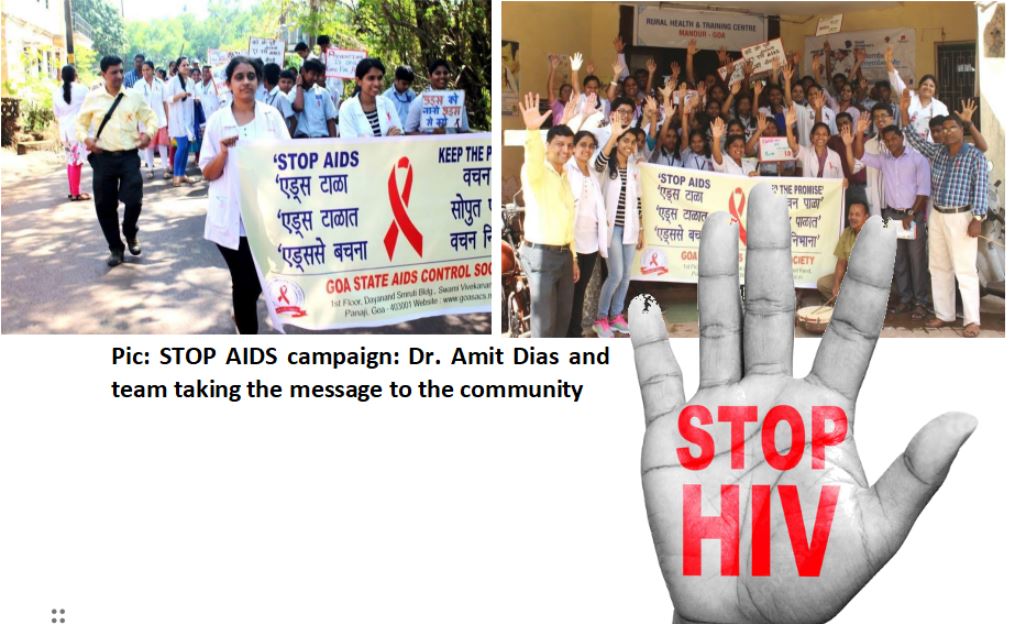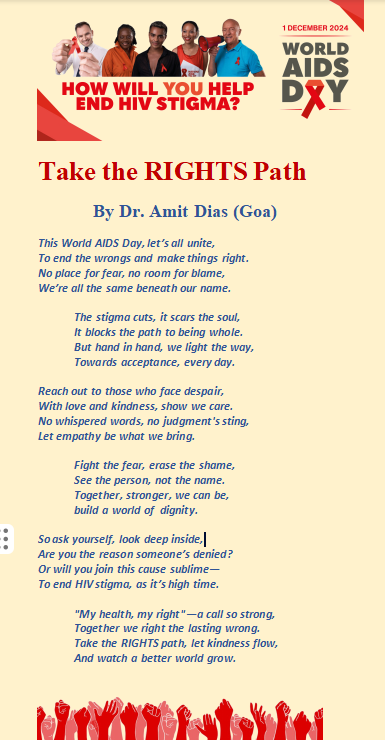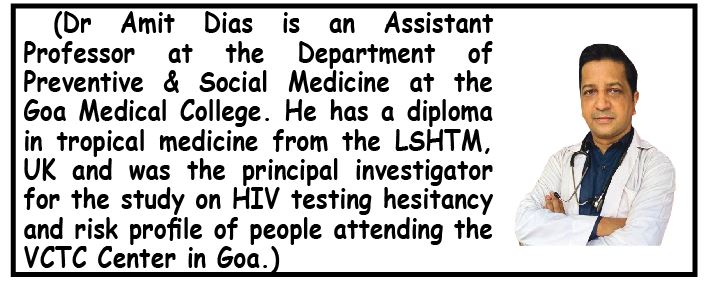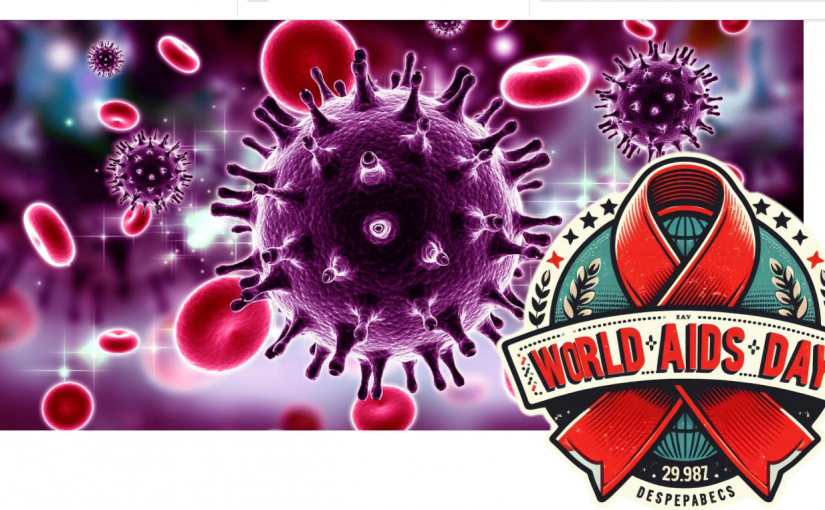World AIDS Day:
On World AIDS Day, December 1, Dr Amit Dias from the Department of Preventive Medicine, GMC, spoke to the Goan Observer, he said, “AIDs does not discriminate, neither should we. AIDS is no longer just a disease it’s a Human Rights Issue- we need to take the Rights path to combat it,” emphasized Dr Dias.
Read and share this full interview with World AIDS Day and help fight HIV/AIDS.
Goan Observer: Thanks for joining us on World AIDS Day… to set the stage for this interview can you start by elaborating on the extent of the problem?
Dr Amit Dias: Globally, approximately 39 million people were living with HIV at the end of 2023. Despite significant progress, around 1.5 million people were newly infected with HIV in 2023, and 630,000 people died of AIDS-related illnesses. In India, there are an estimated 2.3 million people living with HIV, making it one of the highest burdens in Asia. However, the rate of new infections has been steadily declining due to robust public health initiatives.
Q: What is the extent of the problem in Goa?
A: Goa, though smaller in size, has a concentrated epidemic due to its tourism-driven economy, which brings a high degree of mobility and vulnerability. The Goa State AIDS Control Society (GSACS) is doing their best to control the epidemic and has been awarded for their performance. From January 2024 there have been 220 new cases of HIV, 12 cases of AIDS and 47 deaths in people with HIV/AIDS.
Goa has an HIV prevalence rate of around 0.17% among adults. Around 80% of those tested positive are in the 15-49 age group. I was part of the Operational Research Initiative by GSACS to look into the testing hesitancy and the risk profile of people with HIV in Goa. I am happy to state that there is a lot of improvement and we have managed break the barriers to some extent to get people to test themselves. With new anti-retrovirals available free of cost through the ART centers, people with HIV are living healthy lives. We need to be more proactive in raising awareness and emphasizing prevention — KNOW AIDS for NO AIDS is the mantra. We had carried out innovative campaigns in our health centers.

Q: For the benefit of our readers, what is HIV, and how does it differ from AIDS?
A: HIV (Human Immunodeficiency Virus) is a virus that attacks the immune system, specifically CD4 cells, which help fight infections. If left untreated, HIV can lead to AIDS (Acquired Immunodeficiency Syndrome), a condition where the immune system is severely weakened, leaving the body susceptible to opportunistic infections and certain cancers.
Q: Who are at higher risk of getting HIV?
A: Certain populations are at higher risk of acquiring HIV infection due to behavioral, biological or social factors. These include:
- Key Populations
• Sex workers and their clients: Risky sexual practices and limited access to protection methods.
• Men who have sex with men (MSM): Higher prevalence due to unprotected anal sex and stigma limiting access to services.
• People who inject drugs (PWID): Sharing needles increases exposure.
• Health care workers: due to needle stick injuries if universal safety precautions are not observed.
• Prison populations: Limited access to prevention and healthcare, along with high-risk behaviors. - Other High-Risk Groups
• Partners of people living with HIV: Particularly if the HIV-positive partner is not on treatment.
• Women and girls in certain regions: Biological vulnerability and gender inequality increase their risk.
• Adolescents and young adults: Limited awareness and risky behaviors contribute to vulnerability.
• Migrant workers: Increased risk due to mobility and lack of healthcare access.
• Children of HIV-positive mothers: Without preventive measures, transmission can occur during pregnancy, delivery, or breastfeeding.
Prevention, testing, and treatment are essential to reduce risks for these groups.

Q: What is the theme for World AIDS Day this year?
A: The theme for World AIDS Day 2024 is “Take the RIGHTS path: My Health my Right.” It highlights the importance of addressing inequities in HIV care. AIDS does not discriminate, neither should we. HIV is a human rights Issue and we need to take the RIGHTS path to combat it.
Q: What do you mean when you say take the RIGHTS path for HIV?
A: Taking the RIGHTS approach for HIV means addressing the epidemic through a human rights-based framework that ensures dignity, equality, and access for all. This includes:
- Respect for Human Rights: Combating stigma and discrimination in healthcare, employment, and education.
- Inclusion and Equity: Prioritizing access for marginalized groups like LGBTQ+ individuals, sex workers, and migrants.
- Gender Equality: Addressing gender-based disparities and empowering women, who are disproportionately affected.
- Access to Comprehensive Care: Ensuring universal access to HIV testing, treatment, and prevention methods.
- Legal Protections: Enforcing laws against discrimination and repealing punitive policies that deter care.
- Education and Empowerment: Promoting awareness to reduce stigma and empower informed health decisions.
- Accountability: Advocating for government action and involving communities in shaping HIV programs.
The RIGHTS approach ensures an inclusive, compassionate, and effective response to HIV, leaving no one behind.
Q: Can you elaborate on the history of HIV?
A: HIV was first identified in 1981 in the United States. By the mid-1980s, it had spread globally. In India, the first case was reported in Chennai in 1986. Goa’s first reported case came in 1987. Over the years, proactive measures like awareness campaigns, Art programs, and community support have significantly improved the scenario thorough the National AIDS Control Program.
Q: Have they found a cure for HIV?
A: Unfortunately, NO effective cure has been found as of now, but with proper medical care, HIV can be controlled to quite an extent. But as I mentioned, antiretroviral therapy or ART is available for the management. They are provided free of cost at the various ART centers in Goa under the Directorate of Health Services. Once the person takes ART as prescribed, their viral load (amount of HIV in their blood) can becomes undetectable. If it stays undetectable, they can live long, healthy lives and have effectively very low risk of transmitting HIV to an HIV-negative partner through sex.
Today, someone diagnosed with HIV and treated before the disease is far advanced, can live nearly as long as someone who does not have HIV. The opportunistic infections that accompany HIV can be treated, and should be treated in time.
Q: What are opportunistic infections?
A: Opportunistic infections (OIs) are illnesses caused by pathogens that take advantage of a weakened immune system. Common OIs in people living with HIV include tuberculosis, candidiasis, pneumocystis pneumonia, and cytomegalovirus infections. Preventing and treating these infections is a critical part of HIV care.
Q: How do we address the problem of HIV and tuberculosis?
A: TB is the most common opportunistic infection among people living with HIV. Integrated TB-HIV programs focus on early diagnosis, co-treatment and prevention. Screening all HIV patients for TB and vice versa, along with providing preventive therapy, are some strategies.
Q: What can be done to prevent HIV infection?
A: Prevention strategies include using condoms, safe injection practices, regular testing for high-risk individuals, pre-exposure prophylaxis (PrEP) for those at high risk, and education campaigns to increase awareness. Addressing social determinants like poverty and lack of education is also vital.
Q: How can we prevent mother-to-child transmission of HIV, and what is being done about it?
A: Prevention of mother-to-child transmission (PMTCT) involves testing pregnant women for HIV, initiating ART during pregnancy, delivering through safe methods, and providing ART to the infant. India’s NACP has a robust PMTCT program that has significantly reduced transmission rates.
Q: What are the activities under the National AIDS Control Program (NACP)?
A: The NACP focuses on prevention, care, and treatment. Key activities include providing free HIV testing and counseling, ART, harm reduction for drug users, PMTCT services, and public awareness campaigns. It also targets high-risk groups and works to integrate HIV services into the general healthcare system. They do come up with innovative goals like the 95-95-95 initiative from time to time.
Q: What is the 95-95-95 initiative?
A: The 95-95-95 initiative, set by UNAIDS, aims to ensure that by 2030, 95% of people living with HIV know their status, 95% of those diagnosed receive sustained ART, and 95% of those on ART achieve viral suppression. This initiative is crucial for ending the AIDS epidemic as a public health threat by 2030.
Q: What is your message on World AIDS Day?
A: My message is simple: “HIV is no longer a death sentence. Early testing, treatment, and support can ensure a long and healthy life for people living with HIV. Let us come together to end stigma, embrace equality, and ensure universal access to care. Together, we can make AIDS a thing of the past.”

